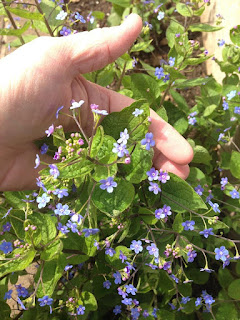 How do we
celebrate those bold orange (or white) creations every autumn? In preparation for Halloween, we carve our
pumpkins, or paint them, and embellish
with bling to create cute or scary faces. We use mini pumpkins in fall décor, both
indoors and out. Pumpkins are the theme
for autumn hay rides as children and adults trudge through fields to find that
perfect pumpkin treasure.
How do we
celebrate those bold orange (or white) creations every autumn? In preparation for Halloween, we carve our
pumpkins, or paint them, and embellish
with bling to create cute or scary faces. We use mini pumpkins in fall décor, both
indoors and out. Pumpkins are the theme
for autumn hay rides as children and adults trudge through fields to find that
perfect pumpkin treasure.
Pie pumpkins
(or canned pumpkin puree) can be used to create culinary delights, like pecan-pumpkin
bars or traditional pumpkin pie.
Pumpkin flavors are used extensively in a variety of beverages, and even
have invaded the realm of doggie treats!
Another way to celebrate our fascination for pumpkins is to roast the
seeds—low and slow in the oven— and eat them plain or toss on salads. Simply rinse seeds thoroughly, place in a
bowl and stir in some canola or olive oil to lightly coat. Spread in single
layer on cookie sheets. Sprinkle with
sea salt; roast in oven at 250º for about an hour, or until seeds are dry and starting
to brown.
 Celebrating
pumpkins (genus Cucurbita) is a widespread tradition across the USA. At a botanical garden in New York, an October
celebration spotlights humongous, giant pumpkins with some weighing over 2,000
lbs. (While Americans are often obsessed with losing weight, we want our
pumpkins to be plump!)
Celebrating
pumpkins (genus Cucurbita) is a widespread tradition across the USA. At a botanical garden in New York, an October
celebration spotlights humongous, giant pumpkins with some weighing over 2,000
lbs. (While Americans are often obsessed with losing weight, we want our
pumpkins to be plump!)
Growing
pumpkins in the home garden is another way to celebrate pumpkins.
In years past, I have grown mini pumpkins and jack-o-lantern pumpkins;
this summer I grew white pumpkins for the
first time, and they provide interesting possibilities for autumn
décor. Pumpkins are considered heavy
feeders, so frequent fertilization is needed.
When pumpkin season draws to a close (after seeds are removed for
roasting) the fleshy shell can be used for composting—lots of nutrients
available that will give back to the
soil for next year’s garden!
M. Lynn
Schmid, Certified Master Gardener
A.A.S. Landscape/Horticulture/Arboriculture
A.A.S. Landscape/Horticulture/Arboriculture















